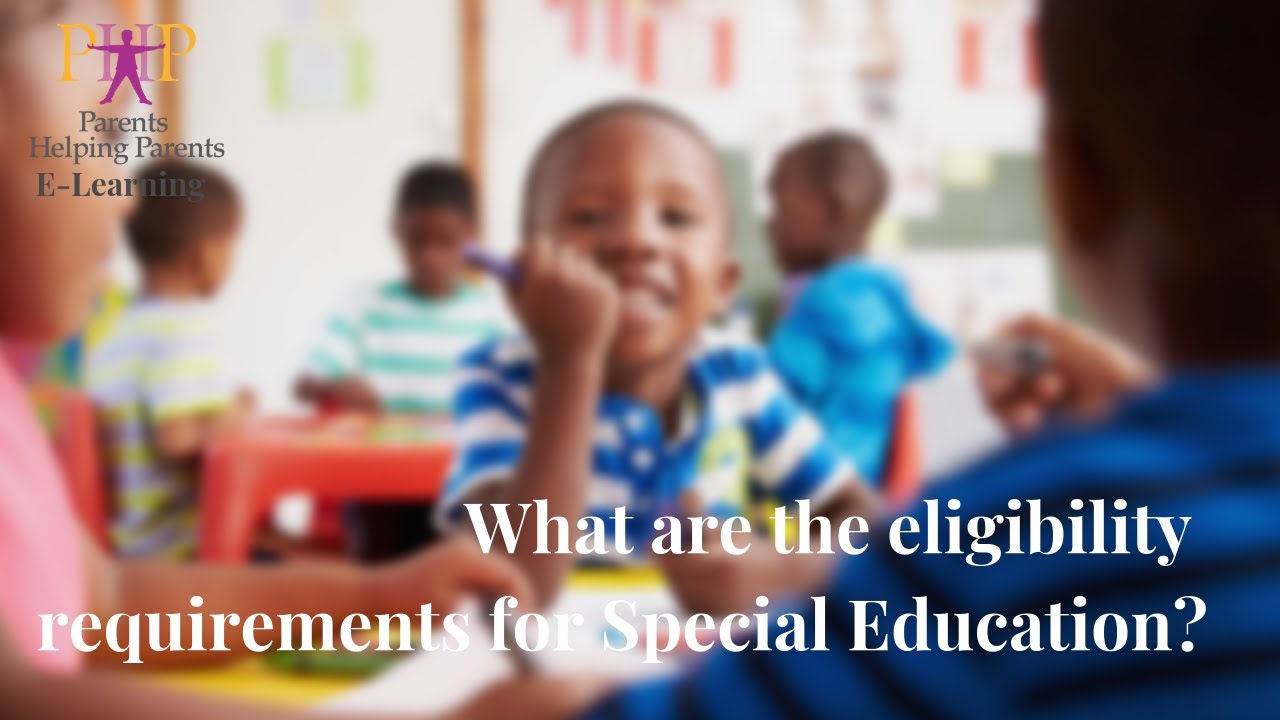Special education is provided to students who have disabilities that affect their learning and require additional support and accommodations.
Understanding Special Education
Special education is a term used to describe tailored instructional services and supports provided to students with learning disabilities or exceptionalities. These exceptionalities may include intellectual disabilities, physical disabilities, emotional or behavioral disorders, or specific learning disabilities.
The importance of special education lies in its ability to address the unique needs of each student. By providing individualized instruction, accommodations, and modifications, special education helps students overcome barriers to learning and achieve academic success. It also promotes inclusivity and ensures that all students have equal access to education.
The main objectives of special education are to enhance students’ academic and social skills, foster independence and self-advocacy, improve communication and problem-solving abilities, and prepare students for future employment or further education.
Evaluation And Eligibility For Special Education
Special education is a vital support system that aims to cater to the unique educational needs of students with disabilities. To determine eligibility for special education services, an evaluation process is conducted. The purpose of this evaluation is to gather comprehensive information about the student’s academic performance, behavior, and overall development.
Evaluation methods can vary but typically involve a combination of assessments such as cognitive tests, academic tests, interviews with parents and teachers, and observations in educational settings. These assessments provide valuable insight into the student’s strengths and challenges, helping to identify their specific needs.
Criteria for qualifying for special education services differ between countries and regions, but generally, there are established guidelines that outline the categories of disabilities that qualify for special education. Some common categories include learning disabilities, intellectual disabilities, speech or language impairments, autism spectrum disorders, and emotional/behavioral disorders.
| Purpose of the Evaluation Process | Assessment Methods for Determining Eligibility | Criteria for Qualifying for Special Education |
|---|---|---|
| To gather comprehensive information about the student’s academic performance, behavior, and overall development | Combination of cognitive tests, academic tests, interviews with parents and teachers, and observations in educational settings | Categories such as learning disabilities, intellectual disabilities, speech or language impairments, autism spectrum disorders, and emotional/behavioral disorders |
Categories Of Disabilities For Special Education Services
Learning disabilities: Students with learning disabilities demonstrate challenges in acquiring and applying skills in specific areas such as reading, writing, and mathematics.
Speech and language impairments: These disabilities affect a child’s ability to communicate effectively, including difficulties with articulation, fluency, and understanding language.
Intellectual disabilities: Individuals with intellectual disabilities have limitations in intellectual functioning and adaptive behavior, affecting their ability to learn and function independently.
Emotional and behavioral disorders: Students with emotional and behavioral disorders struggle with managing their emotions and behaviors, impacting their academic and social functioning.
Autism spectrum disorder: Autism affects social interaction, communication, and behavior, leading to challenges in relating to others and adapting to changes in routine.
Sensory impairments: Students with sensory impairments, such as visual or hearing impairments, may require specialized services to access the curriculum and communicate effectively.
Other health impairments: This category includes conditions like ADHD, epilepsy, and asthma that adversely affect a child’s educational performance.
| Categories | Examples |
|---|---|
| Specific learning disabilities | Dyslexia, Dysgraphia, Dyscalculia |

Credit: www.additudemag.com
Individualized Education Program (iep) Development
An Individualized Education Program (IEP) is a key component of special education, designed to meet the unique needs of students with disabilities. The role of an IEP in special education cannot be overstated. It serves as a roadmap that outlines the necessary supports and accommodations for students to succeed academically and socially.
An IEP includes several components, including but not limited to:
| 1. Present Levels of Performance |
| 2. Measurable Goals |
| 3. Special Education and Related Services |
| 4. Accommodations and Modifications |
| 5. Participation in General Education |
| 6. Transition Services (if applicable) |
An essential aspect of developing an effective IEP is collaboration between parents, teachers, and specialists. The input and expertise of all team members is crucial in ensuring that the educational program is tailored to the student’s specific needs. Regular communication, sharing of observations, and active involvement of all stakeholders contribute to a comprehensive and individualized IEP that promotes student success.
Legal Foundation Of Special Education
Individuals with Disabilities Education Act (IDEA) is the primary legislation that governs special education in the United States. It ensures that children with disabilities have the right to a free and appropriate public education (FAPE). IDEA outlines the eligibility criteria for special education services and provides guidance for the development of Individualized Education Programs (IEPs), which tailor instruction to meet the unique needs of each student.
Section 504 of the Rehabilitation Act protects individuals with disabilities from discrimination in any program or activity receiving federal financial assistance. Unlike IDEA, which specifically focuses on education, Section 504 applies to a broader range of entities and provides accommodations and supports that allow individuals with disabilities to participate fully.
Americans with Disabilities Act (ADA) prohibits discrimination against individuals with disabilities in all areas of public life, including education. It ensures equal opportunities and accessibility by mandating reasonable accommodations and modifications, making education accessible to students with disabilities.
Family Educational Rights and Privacy Act (FERPA) protects the privacy of student education records, including special education records. Educational institutions must obtain consent before disclosing any personally identifiable information and ensure that parents and eligible students have the right to access and review these records.
Transition Planning For Special Education Students
Transition planning plays a crucial role in ensuring successful outcomes for special education students. It aims to prepare these students for life beyond school and facilitate their integration into the community.
Importance of transition planning:
- Helps students set clear goals and objectives for their future.
- Facilitates collaboration between students, parents, educators, and relevant community resources.
- Guides students in developing necessary life skills, such as self-advocacy, decision making, and problem-solving.
- Ensures students are aware of the opportunities available to them in education, employment, and independent living.
- Schools should engage with community agencies, employers, and vocational training centers to provide a comprehensive range of transition services.
- Collaboration helps identify and address potential gaps in support services, ensuring that students have access to the necessary resources.
- Community resources can provide valuable insights into realistic post-school expectations and opportunities.
- Together, schools and community resources can create a network of support to empower students with special needs to achieve their goals.
Early Intervention Programs And Special Education
Early intervention programs play a crucial role in identifying and addressing developmental delays in young children. These programs offer a range of services and support to children with special needs, ensuring that they receive the necessary intervention as early as possible. The benefits of early intervention are manifold:
- Improved outcomes: Early identification and intervention can significantly improve a child’s academic and social outcomes.
- Greater independence: Early interventions focus on developing key skills and strategies that enhance a child’s independence in various areas of life.
- Enhanced communication: Early intervention programs often include speech and language therapy, facilitating improved communication abilities.
- Collaboration: Effective collaboration between early intervention programs and special education services ensures a smooth transition and continuity of support for children in need.
Collaboration between early intervention and special education promotes a holistic and comprehensive approach towards meeting the unique needs of children with disabilities. By working together, these programs can create a seamless support system that maximizes the growth and potential of every child.
Special Education Services In Public Schools
Special education services in public schools aim to provide support and accommodations for students with disabilities, ensuring they have equal access to education. These services can take different forms based on individual needs.
One type of special education service is inclusion, where students with disabilities are placed in a regular classroom alongside their typically developing peers. This approach fosters social interaction and provides a supportive learning environment for all students. Inclusion allows for the sharing of resources and encourages understanding and acceptance of individual differences.
Another type of service is mainstreaming, which involves placing students with disabilities in a general education classroom for most of the day. However, they may receive support or instruction from special education teachers to address their unique needs. Mainstreaming promotes inclusivity while providing specialized assistance.
Classroom accommodations and modifications are essential elements of special education services. These can include adjustments to the physical environment, such as accessible seating or assistive technology, as well as modifications to teaching methods or materials to accommodate different learning styles or abilities.
Supporting Students With Special Education Needs
Effective teaching strategies for special education students involve utilizing a variety of approaches to cater to their individualized learning requirements. It is crucial for educators to understand the specific needs of each student in order to provide targeted support.
Assistive technology plays a significant role in special education, helping students to overcome barriers to learning. Tools such as text-to-speech software, speech recognition programs, and graphic organizers can enhance their ability to access and comprehend instructional materials.
Creating inclusive classroom environments is essential for promoting the success and engagement of special education students. This involves fostering a culture of acceptance and respect, implementing accommodations and modifications, and promoting collaborative learning experiences.
Advocacy For Special Education Rights
Advocating for special education rights is crucial for ensuring that children with disabilities receive the appropriate support and accommodations they need to succeed in school. Parents play a key role in this advocacy process, as they have specific rights when it comes to their child’s education. Understanding these parental rights is essential in advocating for special education services.
Parents can start by familiarizing themselves with their child’s Individualized Education Program (IEP) or 504 plan. This document outlines the accommodations and support that the child is entitled to receive. Reviewing the IEP or 504 plan regularly and communicating with the school to ensure its implementation is an important strategy for advocacy.
Additionally, parents can engage in open and proactive communication with the school and the special education team. Building a positive relationship and effectively expressing concerns and goals can lead to better educational outcomes for the child. It is crucial to maintain a record of all communication and important documents for future reference.
In cases where parents feel that their child’s needs are not being adequately met, they have the right to request an evaluation or re-evaluation for special education services. Being informed about the evaluation process, including timelines and the types of assessments used, can help parents navigate this aspect of the advocacy process.
Overall, by understanding parental rights, engaging in open communication with the school, and staying informed about special education processes, parents can effectively advocate for their child’s special education needs.
Frequently Asked Questions Of What Qualifies For Special Education
What Are The 3 Criteria For Learning Disability?
The three criteria for a learning disability include difficulties in academic skills, below-average intellectual ability, and challenges in adaptive behavior. These criteria help identify individuals who require additional support in their learning process.
What Qualifies A Child For An Iep In Texas?
A child in Texas qualifies for an Individualized Education Program (IEP) based on specific criteria, including having a disability that affects their educational performance and needing special education services.
What Two Criteria Must Be Met For A Student To Be Eligible To Receive Special Education Services Quizlet?
To be eligible for special education services, a student must meet two criteria: they must have a documented disability and demonstrate a need for specialized instruction or related services.
What Is The Difference Between Special Needs And Disability?
Special needs refers to a broad range of challenges that may impact a person’s physical, cognitive, or emotional abilities. Disability, on the other hand, refers to a specific condition that substantially limits a person’s everyday activities and functioning.
Conclusion
Understanding the qualifications for special education is crucial for providing the necessary support and resources to students with diverse learning needs. By recognizing the eligibility criteria and the individualized education plans in place, we empower students to reach their fullest potential.
As educators and advocates, it is our responsibility to ensure that every child receives the appropriate education and related services they deserve. Together, we can foster an inclusive and equitable educational environment for all students.







